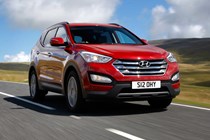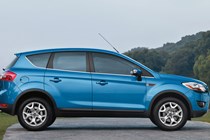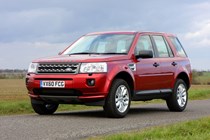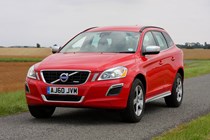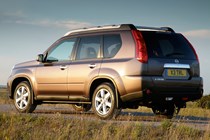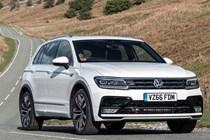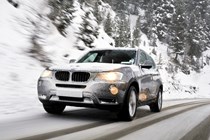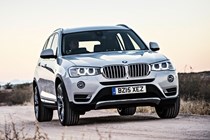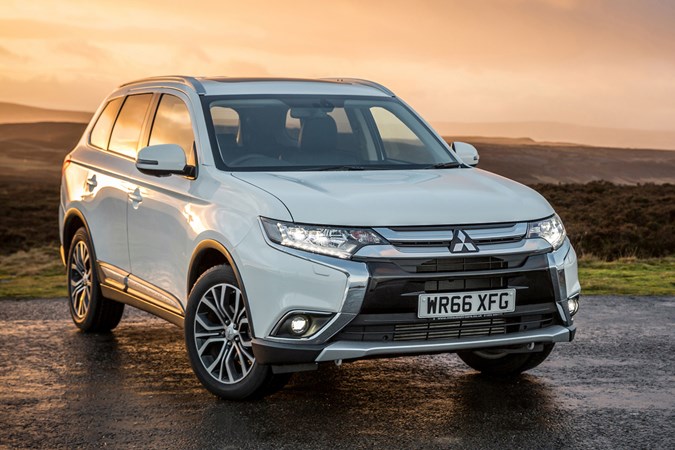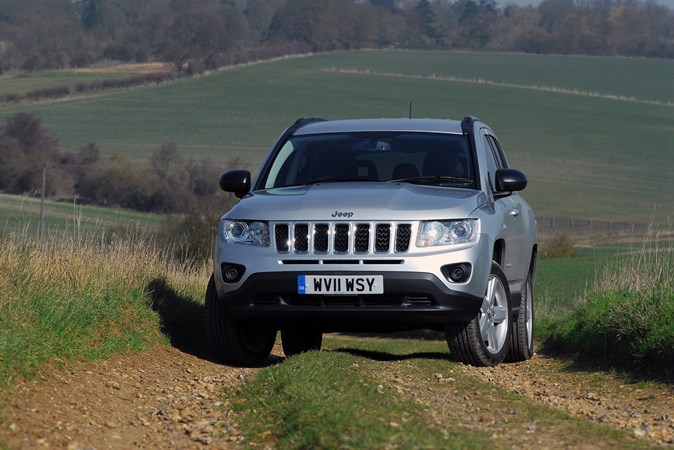Looking for a second hand family car that can handle anything? A used 4x4 car should be able to meet all the demands of a young family while providing safe, reassuring transport in all weathers. Conventional petrol and diesel 4x4s are getting rarer in new car showrooms, but search for a used car and you can browse a back catalogue of every brand’s greatest hits.
We’ve picked our favourite used family 4x4s to suit all budgets, based on three simple requirements:
- They must offer a little bit of off-road ability – enough to deal with rough tracks, bumpy snow-covered carparks, and getting out of trouble if you need to drive onto verges to avoid hazards
- They must be easy to drive and able to use four-wheel drive in all conditions
- They must be easy to find in good condition, and represent the best value in that price range
If you don’t need to go off-road or climb mountains in snow, check our our recommended best used SUVs. Most cars and SUVs are perfectly safe in winter as long as you choose appropriate winter tyres, after all.
Over the years the Parkers team has reviewed a vast array of family SUVs, so click through to find out out more about each vehicle here before searching for 4x4s for sale near you. Be sure to read to the end, as we’ve got some top tips for buying your dream off-roader as well.
Get the best of both worlds as Volvo safety meets Land Rover 4x4 expertise
The XC60 maintained the Swedish brand’s commitment to safety with a top five star Euro NCAP rating. All models feature ‘City Safety’ as standard, one of the first autonomous emergency braking systems. It’s designed to automatically stop the car if it detects an imminent collision with the car in front in urban traffic, at speeds up to 19mph.
What’s the best Volvo XC60 to look for?
Avoid the high-performance, 3.0-litre petrol T6 (which is rare anyway), go for the diesel D5 for a good blend of performance and economy. All diesel 4x4 models of XC60 are fitted with Volvo’s own 2.4-litre five-cylinder engine (which is not a Ford unit, despite popular opinion often claiming so). You will need a later version with stop/start tech if you plan on driving in clean air zones or ULEZ.
Read our full Volvo XC60 Estate review
Read our Owners Reviews
Pros
- Excellent safety for the age of design
- Comfortable, secure handling
Cons
- Neglected automatics expensive to fix
- 4x4 models tied to larger engines only
Capable small family 4x4 is fun on-road as well
And 4x4 it is – despite the aspirational nature of the BMW badge, this is not an SUV for show. There is a 2WD model which follows the BMW tradition of rear-wheel drive, but most have xDrive 4x4. You can combine that with another BMW hallmark – the straight-six diesel engine. Although related to the 3-series in name it’s closer to a 5-series in interior space (and exterior dimensions), so don’t dismiss it as ‘too-small’ without trying one first.
What’s the best BMW X3 to look for?
For everyday use an xDrive 20d with low mileage and automatic gearbox would be our first choice. It’s hard to deny the impressive economy for the performance you get with an xDrive 35d M Sport though – it makes an Evoque of the same age look expensive and slow.
Read our full BMW X3 Estate review
Read our Owners Reviews
Pros
- BMW’s devotion to driver involvement extends to small 4x4s
- Diverse range of engines and trim, most are 4x4
Cons
- Watch out for sDrive – it’s rear-wheel drive
- Some reliability issues affect early engines
Simply the best design for a family 4x4 – if only it were as reliable as it is capable
It’s abilities on the rough stuff are truly impressive thanks to tall suspension and clever electronics. Before the Range Rover Evoque came along this was the family SUV to be seen in – but it took a while to shake the reliability issues of the first Freelander.
As a used buy, a good one makes a lot of sense. Making the most of efficient packaging, it’s one of the most cavernous mid-sized 4x4s thanks to its boxy shape. Boot size wades in at 755 litres (even more if you fold the rear seats flat) and there’s plenty of room in the back for two adults.
Which Freelander 2 to look for?
Unless cheap and in excellent condition, avoid the pre-2009 Freelander 2s. Reliability is questionable (auto gearboxes and steering racks main culprits), and the 4x4 was upgraded to a more robust system.
We’d recommend a 2009 on SD4 (the more powerful version of the diesel engine) in a mid-spec trim such as GS. If you want a luxurious experience, the rare 3.2 six-cylinder petrol is very impressive but has poor economy and many have been modified with aftermarket LPG.
There is a 2WD version (eD4), so watch out if you see some listed that look unusually cheap for the condition and mileage. Not to be confused with the TD4 e, which has stop/start technology for better fuel economy.
Read our full Land Rover Freelander Station Wagon review
Read our Owners Reviews
Pros
- Practical, spacious design
- Badge prestige and proven 4x4 capability
Cons
- Early models still fragile
- Good ones are expensive, no Euro 6 diesels
Plug-in pioneer also offers a conventionally-powered seven-seater for larger families
There’s a good reason to choose a regular Outlander though – it’s a seven seater, and the two rear-most seats folding flat to the floor to create a huge boot space. The Outlander’s interior isn’t ia work of art, but it is practical, well thought out and durable.
For the cheapest option, the earlier Outlander Mk2 was launched in 2007 and revised in 2010 with an impressive 2.2-litre diesel. Find a good example of the 174bhp version with a six-speed manual and it’s an excellent choice if you don’t need to visit towns and cities with clean air zones such as London’s ULEZ. It was also sold as the Peugeot 4007 and Citroen C-Crosser.
What’s the best Mitsubishi Outlander to look for?
Five-seater buyers have an easy choice – the later 2018-on Outlander PHEV 2.0-litre if you have the ability to plug in regularly for charging (such as off-street parking or charging at work). In all versions, the higher the spec number, the better the kit – look for ‘hs’ if you want extra safety features. The good news is that the seven-seater diesel can be found with a Euro 6, ULEZ-compliant engine so you can enjoy traditional high-mpg engineering.
Read our full Mitsubishi Outlander Estate review
Read our Owners Reviews
Pros
- Late-model PHEV is powerful and economical
- Euro 6 diesel avoids emissions charging
Cons
- PHEV only makes sense if you can plug in regularly
- Some reliability issues, dealer support likely to fade out
A capable, rugged alternative to a Qashqai is ideal for rural life
Setting it apart from the Qashqai, which was also available as a 4x4, the X-Trail Mk2 is reasonably capable off-road thanks to decent ground clearance. It can be locked into all-wheel drive when tackling slippery ground and has electronic limited-slip using the brakes to avoid wheelspin. Best of all, it’s proven very reliable compared with rivals.
Which Nissan X-Trail Mk2 to buy?
The answer is ‘the best you can find’, as these cars were not expensive new and many have been neglected and run into the ground. For running a 4x4 on budget avoid automatics and petrol engines. We’d look for the 173bhp 2.0-litre turbodiesel with the six-speed manual. If you have to contend with ULEZ you’ll want the Nissan X-Trail Mk3, which is less off-road focused and more like a bigger Qashqai.
Read our Owners Reviews
Pros
- Selectable 4x4 saves fuel and is fairly robust
- Practical design and rugged trim
Cons
- Some weak engines in the range, no ULEZ compliant diesel
- CVT gearbox sluggish and weak if neglected
If your 4x4 aspirations are about staying on the road, the Tiguan’s got the edge
It also comes with some great driver aids including parking sensors, parking assist (steers the car into a parallel parking space) and stability control as standard. There’s a choice of two-wheel as well as four-wheel drive, plus VW offers an ‘eco’ version dubbed ‘Bluemotion’ for improved fuel consumption and lower emissions.
What’s the best used Volkswagen Tiguan to look for?
We’d recommend going for the 2.0TDi 140 diesel SE as the best compromise between performance and good fuel economy, plus the SE spec delivers a lot of kit for the money.
Anyone planning more extreme cross country routes should consider the ‘Escape’ model, which has been specially adapted for serious off-roading.
Read our full Volkswagen Tiguan Estate review
Read our Owners Reviews
Pros
- Refined, predictable handling
- Efficient use of space inside
Cons
- 4x4 models are rare
- Poor ground clearance for off-road use
Aspirational SUV from Ford is available with all-wheel drive option – but it’s rare
Since launching as an all-new style of car from Ford in 2008, the Kuga has quickly established itself as a family favourite. While early Ford Kuga Mk2s are getting affordable, AWD models are hard to find and expensive.
The interior is spacious, stylish compared with contemporary rivals, and comfortable. Its on-road driving manners are smooth and it’s perfectly suited to family motoring, not least thanks to a large-sized boot. The only downside is a lack of engine choice. Many buyers chose diesel, in particular the 2.0TDCi with two-wheel drive.
What’s the best Ford Kuga to look for?
While the reduction in emissions and improvements in fuel consumption over four-wheel drive were worth having new, it means you’ll have to search carefully to find your 4x4 model – and it does mean you’ll want to look to the next generation of Kuga if you have to drive in ULEZ or clean air zones.
Avoid the 2.5-litre petrol version as fuel consumption will hit low 20mpg on average and road tax is expensive. The trim to seek out is Titanium, though the entry level Zetec won’t disappoint either.
Read our full Ford Kuga Estate review
Read our Owners Reviews
Pros
- Handling inherited from Focus, yet useful increase in clearance
- Plenty of cars to choose from
Cons
- AWD models are rare
- Diesel prone to problems at high mileage, not ULEZ compliant
Sensible family 4x4 is becoming a bargain, just as the original warranty expires
Thanks to the body’s seven seat space, there’s plenty of room for cargo and with weight saving and more efficient powertrains, it’s not as expensive to run as you might assume. There’s not much choice – it’s got one engine option of a 2.2-litre diesel – but why would you need anything else? Most will be ULEZ compliant, and it’s easy to find 4x4 models.
What’s the best Hyundai Santa Fe to look for?
The six-speed manual extracts the best performance and economy from the 2.2-litre diesel, and Premium SE specification is very generous.
Read our full Hyundai Santa Fe Estate review
Read our Owners Reviews
Pros
- Lighter, more efficient Santa Fe maximises passenger space
- No-fuss 4x4 system has drive modes for off-road use
Cons
- Hopefully you like diesel engines, because that’s all it offers
- Reflects an earlier era of Hyundai trim and design
Basic interior and rugged exterior, with low used values – an excellent rural workhorse
The Compass doesn’t match its rivals for refinement and quality interiors but its upside is it costs significantly less. It shares a fair amount of engineering with the equally capable Mitsubishi Outlander, but with a transatlantic feel that has great kerb appeal.
What’s the best Jeep Compass to look for?
We’d recommend the 2.2 diesel as it makes the most sense for its economy, plus the mid-spec Sport+ model as it features climate control as standard. Although it uses the modern Mercedes OM651 engine, it doesn’t meet Euro 6 standards so for ULEZ you’ll want to look at the Jeep Renegade or 2017-on Compass.
Looking for something smaller and ULEZ compliant? Check out the Jeep Renegade
Read our full Jeep Compass Estate review
Pros
- Easy to use 4x4 tech designed to meet Jeep standards
- Tall, narrow design ideal for busy villages
Cons
- Cheap to buy used, but feels it
- Dealer and parts support very limited
What about a used pickup as a family 4x4?
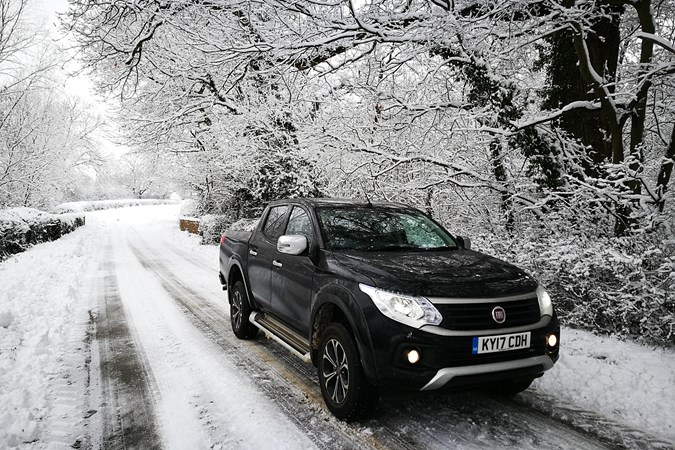
Pros:
✅ Strong chassis and 4x4 systems
✅ Cheaper than an SUV of the same capability
Cons:
❌ Lack of grip if not carrying heavy loads
❌ Few able to use 4x4 on tarmac
Good 4x4 cars are expensive, so the temptation of a big, cheap pickup is easy to understand. Buying a secondhand pickup for winter driving can make sense for some drivers, and the popularity of double cab models for families is undeniable.
However, in isolation most pickups on the UK market are not worth buying for bad weather and snow reasons.
- Most pickups sold in the UK have part-time 4x4 which cannot be used on tarmac
- Pickups default to rear-wheel drive and when unladen, lack traction
- Most cheap pickups will need expensive new tyres for winter safety
- Under emergency braking many older pickups are significantly less safe than contemporary cars
- A cheap used pickup is usually at the end of its working life
What’s the best double cab pickup to look for?
Bearing all those facts in mind these are the used pickups we would recommend for driving in snow, as these pickups feature permanent four-wheel drive:
- Mitubishi L200 Series 5 and Series 6
- Fiat Fullback
- Some models of Volkswagen Amarok
- The Mercedes X-Class 350 V6 (not the 220 and 250)
It’s also worth remembering that the advertised price of a commercial vehicle such as a pickup will often exclude VAT, so make sure it’s the bargain it appears to be if not buying privately.
Visit Parkers Vans and Pickups to find out more about the latest commercial 4x4s
Buying a family 4x4? Follow these top tips to make the right choice
There’s no point paying a premium for a used 4x4 car or SUV if the technology isn’t working correctly. It can be difficult to test how functional everything is with some models, as manufacturers implement 4x4 in different ways and not every system allows the driver to control when it operates.
When considering a 4x4 model of a car that is two-wheel drive normally, bear in mind that many components may be different and more expensive as a result. Popularity is important as well – if a brand sells tens of thousands of a popular model, but only a couple of hundred 4x4 versions you may find it hard to get spares if anything breaks.
For this reason it’s important to make sure everything is in good condition and check the MOT history online for advisories around exhaust condition, corroded or concealed brake pipes, and wear to driveshaft boots and wheel bearings.
Check the tyres when buying any 4x4
Mismatched tyres can break 4x4 systems: true or false?
Off road tyres are expensive, especially dual purpose ones. Check tread depth and tyre condition and budget if they need replacing. Don’t forget the spare – a full sized one is worth having over a space saver. For driving in snow winter tyres are a must-have – a good 4x4 family car from a caring owner will probably have a set of summer tyres on alloy wheels, and winter tyres on steel.
When looking at a used car with four-wheel drive, particularly vehicles with a viscous centre coupling, be sure to check the service history for tyre changes in complete sets. If three tyres are worn down to 3mm and the owner replaces one with a 7-8mm one, it puts a strain on the slip-detecting hardware that engages all-wheel drive and can overheat or break the transmission.
It is good practice on all four wheel drive systems to make sure the tyres are the same brand, pattern, size and condition, and at the correct pressure for the best fuel economy and most effective grip. We would always look for money spent on tyres in the history of a 4x4 vehicle, even if it has a full set of new ones when viewed – particularly at higher mileages.
Common 4x4s that are most likely to suffer damage to the AWD system if mismatched tyres are used:
- Land Rover Freelander – failure of the VCU and IRD
- Land Rover Freelander 2 pre 2010 – failure of the VCU and IRD
- Volvo AWD – models without ‘Instant Traction’ such as original XC70/V70 AWD
- Jeep Grand Cherokee – Quadra Drive with NP247 transfer case
- Volkswagen Syncro and early 4Motion before 1998
- Audi Quattro with viscous centre differential
- Subaru with viscous coupling
- Suzuki ALLGrip (except Jimny and electronic systems such as SX4)
- Fiat Panda Mk2 4x4 pre-2008 (Panda Mk1 has no centre differential and is part-time 4x4)
- BMW X5 pre-xDrive
- Porsche Cayenne and Volkswagen Touareg (early models)
As you can see, buying a mid 1990s to early 2000s AWD vehicle has a high risk of getting a car with a viscous coupling and sensitivity to mismatched tyres. Later systems with electronic control are capable of fully disconnecting the rear axle and less likely to be damaged, though manufacturers still recommend matched tyres all round.
Transmission service
The all-wheel drive systems are very expensive to replace so have they been serviced regularly? The service book should tell you and double-check when the transmission oil should have been changed. The majority of electronic, automatic or shift-on-the-fly AWD systems since 2004 are based on Haldex technology that should be serviced every 40,000 miles.
Inspect the brakes
Off-roaders give brakes a hard time. Check discs for scoring and wear, plus the thickness of the pads. If the car has racked up more than 60k miles ask if discs and pads have been renewed. If not it’s a job that’s likely to be due so budget for it. Corroded brake pipes may involve much more work to replace on cars that have different rear axles or subframes to their 2WD equivalents.
Towing tasks
If you see a tow bar ask what’s been hitched to the back and how often. The heavier the trailer the more strain on the transmission and suspension, so make sure the car’s braked tow weight limit is up to the job. Likewise if you’re planning on towing.
Detachable extras
Some modern 4x4s come with a spare number plate and detachable tow bar so make sure they’re present before buying.
Check trim and boot
Kids can stress test interiors like nothing else so make sure all handles, switches and trim are securely attached and work. Check boots for any signs of dog transporting – claws wear out boot floors and seat backs.
Just so you know, we may receive a commission or other compensation from the links on this website - read why you should trust us.



